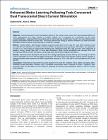| dc.contributor.author | WITNEY, ALICE | en |
| dc.date.accessioned | 2014-11-26T12:55:51Z | |
| dc.date.available | 2014-11-26T12:55:51Z | |
| dc.date.issued | 2013 | en |
| dc.date.submitted | 2013 | en |
| dc.identifier.citation | Karok S, Witney AG, Enhanced motor learning following task-concurrent dual transcranial direct current stimulation., PloS one, 8, 12, 2013, e85693 | en |
| dc.identifier.other | Y | en |
| dc.identifier.uri | http://hdl.handle.net/2262/72199 | |
| dc.description | PUBLISHED | en |
| dc.description.abstract | OBJECTIVE:
Transcranial direct current stimulation (tDCS) of the primary motor cortex (M1) has beneficial effects on motor performance and motor learning in healthy subjects and is emerging as a promising tool for motor neurorehabilitation. Applying tDCS concurrently with a motor task has recently been found to be more effective than applying stimulation before the motor task. This study extends this finding to examine whether such task-concurrent stimulation further enhances motor learning on a dual M1 montage.
METHOD:
Twenty healthy, right-handed subjects received anodal tDCS to the right M1, dual tDCS (anodal current over right M1 and cathodal over left M1) and sham tDCS in a repeated-measures design. Stimulation was applied for 10 mins at 1.5 mA during an explicit motor learning task. Response times (RT) and accuracy were measured at baseline, during, directly after and 15 mins after stimulation. Motor cortical excitability was recorded from both hemispheres before and after stimulation using single-pulse transcranial magnetic stimulation.
RESULTS:
Task-concurrent stimulation with a dual M1 montage significantly reduced RTs by 23% as early as with the onset of stimulation (p<0.01) with this effect increasing to 30% at the final measurement. Polarity-specific changes in cortical excitability were observed with MEPs significantly reduced by 12% in the left M1 and increased by 69% in the right M1.
CONCLUSION:
Performance improvement occurred earliest in the dual M1 condition with a stable and lasting effect. Unilateral anodal stimulation resulted only in trendwise improvement when compared to sham. Therefore, task-concurrent dual M1 stimulation is most suited for obtaining the desired neuromodulatory effects of tDCS in explicit motor learning. | en |
| dc.format.extent | e85693 | en |
| dc.language.iso | en | en |
| dc.relation.ispartofseries | PloS one | en |
| dc.relation.ispartofseries | 8 | en |
| dc.relation.ispartofseries | 12 | en |
| dc.rights | Y | en |
| dc.subject | Physiology | en |
| dc.title | Enhanced motor learning following task-concurrent dual transcranial direct current stimulation. | en |
| dc.type | Journal Article | en |
| dc.type.supercollection | scholarly_publications | en |
| dc.type.supercollection | refereed_publications | en |
| dc.identifier.peoplefinderurl | http://people.tcd.ie/awitney | en |
| dc.identifier.rssinternalid | 90528 | en |
| dc.identifier.doi | http://dx.doi.org/10.1371/journal.pone.0085693 | en |
| dc.rights.ecaccessrights | openAccess | |
| dc.subject.TCDTheme | Ageing | en |
| dc.subject.TCDTheme | Neuroscience | en |
| dc.subject.TCDTheme | Next Generation Medical Devices | en |
| dc.identifier.orcid_id | 0000-0002-3726-8479 | en |




